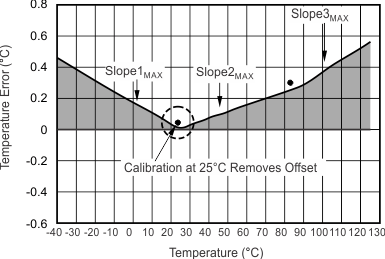SLOS887F September 2014 – June 2022 TMP112-Q1
PRODUCTION DATA
- 1 Features
- 2 Applications
- 3 Description
- 4 Revision History
- 5 Description (continued)
- 6 Pin Configuration and Functions
- 7 Specifications
-
8 Detailed Description
- 8.1 Overview
- 8.2 Functional Block Diagram
- 8.3 Feature Description
- 8.4 Device Functional Modes
- 8.5 Programming
- 9 Application and Implementation
- 10Power Supply Recommendations
- 11Layout
- 12Device and Documentation Support
- 13Mechanical, Packaging, and Orderable Information
Package Options
Mechanical Data (Package|Pins)
- DRL|6
Thermal pad, mechanical data (Package|Pins)
Orderable Information
9.1.2 Using The Slope Specifications With a 1-Point Calibration
The initial accuracy assurance at 25°C with the slope regions provides an accuracy that is high enough for most applications. However, if higher accuracy is desired, this increase can be achieved with a 1-point calibration at 25°C. This calibration removes the offset at room temperature, thereby reducing the source of error in a TMP112-Q1 temperature reading down to the curvature. Figure 9-2 shows the error of a calibrated TMP112-Q1 device.
 Figure 9-2 Calibrated Accuracy and Slope Curves versus Temperature
Figure 9-2 Calibrated Accuracy and Slope Curves versus TemperatureUsing the previous example temperature range of 0°C to 50°C, the worst-case temperature error is now reduced to the worst-case slopes because the offset at 25°C (that is, the maximum and minimum temperature errors of 0.3°C and –0.5°C) is removed. Therefore, a user can expect the worst-case accuracy to improve to 0.175°C.